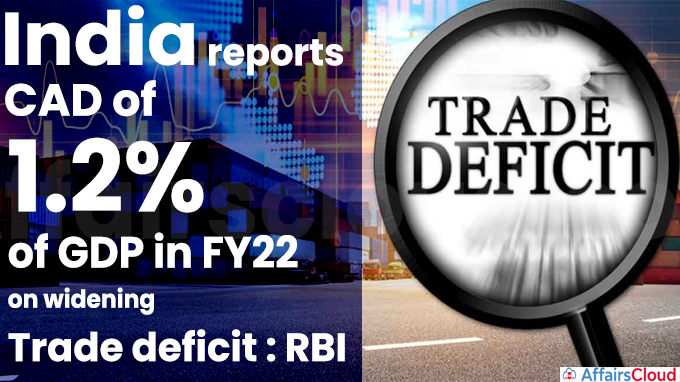
On June 22, 2022, the Reserve Bank of India (RBI) released data on India’s balance of payments (BoP) for the fourth quarter (Q4), i.e., January-March 2021-22/FY22.
As per it, India’s current account deficit (CAD) decreased to US$ 13.4 billion(bn) (1.5% of GDP) in Q4:FY22 from US$ 22.2 billion (2.6% of GDP) in Q3:FY22 due to a wider trade deficit. On an annual basis, CAD recorded a deficit of 1.2% of GDP in FY22 as against a surplus of 0.9% in FY21 because the trade deficit widened to USD 189.5 billion in FY22 from USD 102.2 in FY21.
- The CAD occurs when the value of goods and services imported and other payments exceeds the value of export of goods and services and other receipts by a country in a particular period. Similarly, Goods imports in India stood at USD 618.6 billion in FY22 as against USD 398.5 billion in FY21.
Other Highlights of India’s BoP during Q4:2021-22
i.Net Foreign Direct Investment (FDI) stood at US$ 13.8 billion which was higher than US$ 2.7 billion in Q4FY21.
ii.Net Foreign Portfolio Investment (FPI) recorded an outflow of US$ 15.2 billion, mainly from the equity market.
iii.Net External Commercial Borrowings (ECBs) to India were lowered at US$ 3.3 billion as compared with US$ 6.1 billion in Q4FY21.
iv.The Foreign Exchange Reserves (on a BoP basis) was decreased by US$ 16.0 billion as against an accretion of US$ 3.4 billion in Q4FY21.
v.The merchandise trade deficit narrowed to $54.5 billion as compared with a deficit of $60.4 billion in Q3FY22.
vi.Net services receipts increased, both sequentially and on a year-on-year (y-o-y) basis amid rise in net earnings from computer and business services.
vii.Private transfer receipts, mainly representing remittances by Indians employed overseas, increased to US$ 23.7 billion, up by 13.4% from Q4:2020-21.
viii.Net outgo from the primary income account, largely reflecting net income payments on foreign investment, decreased sequentially as well as on a y-o-y basis.
Key Highlights of BoP during FY22
i.Net FDI inflows at US$ 38.6 billion were lower than US$ 44.0 billion in FY21.
ii.Net FPI recorded an outflow of US$ 16.8 billion as against an inflow of US$ 36.1 billion in FY21.
iii.Net ECBs to India recorded an inflow of US$ 7.4 billion as compared with US$ 0.2 billion in FY21.
iv.There was an accretion of US$ 47.5 billion to foreign exchange reserves (on a BoP basis).
Click Here for Official Notification
Adverse Global Events may lead to $100.6 bn Portfolio Outflows: RBI Paper
As per the paper titled ‘Capital Flows at Risk: India’s Experience’, there is only 5% chance of potential portfolio outflows from India of the order of 3.2% of GDP or $100.6 billion in a year, amid Covid-19 contraction in GDP growth.
- In case of black swan event also, which is a combination of all adverse shocks, there is 5% chance of outflows under portfolio investments of 7.7% of GDP and short-term trade credit retrenchment of 3.9% of GDP.
The paper is co-authored by RBI Deputy Governor Michael Patra, Harendra Behera, and Silu Muduli, and is released in RBI’s June 2022 Bulletin. However, the views are personal and do not represent those of the RBI.
The black swan theory was put forward by author and investor Nassim Nicholas Taleb in 2001, and later popularised in his 2007 book – The Black Swan: The Impact of the Highly Improbable.
RBI bars credit lines for Prepaid Wallet Topup
RBI has barred loading of non-banking, Prepaid Payment Instruments (PPIs) such as wallets and prepaid cards, from credit lines. However, RBI guidelines permit PPIs to be loaded by either cash, debit to a bank account, credit & debit cards and other payment instruments.
- Any non-compliance in this regard may attract penal action under provisions contained in the Payment and Settlement Systems Act, 2007.
Reason behind this decision:
This decision has been taken to stop card-based fintechs and firms operating as neobanks that have tied up with banks for offering credit lines.
- A neobank is a digital bank that does not have any branches.
What is a credit line?
In a credit line, the bank makes available funds to the customer, which turns into a loan when the borrower draws the money.
Recent Related News:
i.In accordance with the RBI data, a total of 27 Scheduled Commercial Banks (SCBs) and Financial Institutions (FIs) have reported 96 cases of fraud, worth Rs 34,097 crore in the first nine months of FY22 (April-December 2021).
ii.RBI issued Guidelines on the establishment of 24X7 Digital Banking Units (DBUs) to offer products and services in both self-served and assisted mode w.e.f. April 7, 2022.
About Reserve Bank of India (RBI):
Establishment– 1st April 1935
Headquarters– Mumbai, Maharashtra
Governor– Shaktikanta Das




